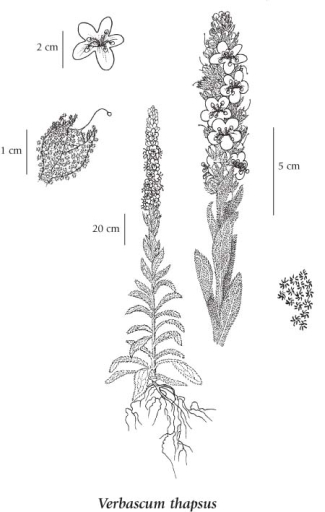great mullein (common mullein)
Scrophulariaceae (Butterfly-bush family)
Introduction to Vascular Plants
Species Information
General:
Robust biennial herb from a taproot; stems single, erect, 0.5-2 m tall; stem, leaves and inflorescence densely woolly with star-shaped or forking-branched, felted hairs.
Leaves:
Basal leaves in a rosette, broadly lanceolate, 10-45 cm long, tapering to a stalked base, vaguely round-toothed to entire; stem leaves numerous, alternate, progressively reduced upward, becoming unstalked, with clasping leaf-bases decurrent along the stem.
Flowers:
Inflorescence a dense, bracted, spike-like, terminal cluster, 10-50 cm long, of numerous very short-stalked flowers; corollas yellow, wheel-shaped, 1.5-3 cm across, 5-lobed, the lobes nearly equal, concave, the tube very short; calyces 5-12 mm long, hairy, deeply 5-lobed, the lobes lanceolate; stamens 5, the 3 upper filaments white- or yellow-long-hairy, the 2 lower filaments longer, smooth or nearly so.
Fruits:
Capsules, broadly egg-shaped, 7-10 mm long, woolly; seeds numerous, longitudinally ridged.
Illustration

If more than one illustration is available for a species (e.g., separate illustrations were provided for two subspecies) then links to the separate images will be provided below. Note that individual subspecies or varietal illustrations are not always available.
Illustration Source: The Illustrated Flora of British Columbia
Ecology
The table below shows the species-specific information calculated from
original data (BEC database) provided by the BC Ministry of Forests and Range.
(Updated August, 2013)
| Site Information |
Value / Class |
||
|
Avg |
Min |
Max |
|
| Elevation
(metres) |
938 | 295 | 1943 |
| Slope
Gradient (%) |
31 | 0 | 140 |
|
Aspect (degrees) |
192 | 0 | 360 |
| Soil
Moisture Regime (SMR) [0 - very xeric; 4 - mesic; 8 - hydric] |
2 | 0 | 8 |
| Modal
Nutrient Regime
Class |
C | ||
| #
of field plots species was recorded in: |
339 | ||
| Modal
BEC Zone Class |
IDF | ||
|
All BEC Zones (# of stations/zone) species was recorded in |
BG(32), ESSF(12), ICH(18), IDF(177), MS(25), PP(62) | ||
|
Source:
Klinkenberg 2013
|
|||
Habitat and Range
Dry roadsides, gravel pits, fields and waste places; common in S BC north to 53degreeN, rare north to 55degreeN; introduced from Eurasia.Status Information
Taxonomic Keys
1. Plants more or less densely stalked-glandular upward, essentially smooth below; leaves green.......................Verbascum blattaria
1. Plants woolly throughout with branched, non-glandular hairs; leaves greyish. 2. Inflorescences loose, often branching at the base; leaves unstalked, not decurrent on the stem or only slightly so; plants loosely woolly...........................Verbascum phlomoides 2. Inflorescences dense, simple; leaves stalked, at least below, decurrent on the stem, usually as far as the next leaf below; plants densely woolly............................Verbascum thapsus |